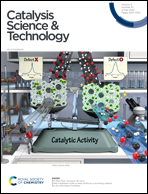Boosting photocatalytic hydrogen evolution of covalent organic frameworks by introducing 2D conductive metal–organic frameworks as noble metal-free co-catalysts†
Abstract
Covalent organic frameworks (COFs) as new photocatalysts for hydrogen evolution have aroused considerable interest over the past few years. However, most of COF-based photocatalysts require expensive and rare Pt co-catalysts to achieve a high hydrogen evolution rate. Here, a series of Tp-Pa-2-COF-based photocatalyst materials with porous 2D conductive metal–organic framework (MOF) Cu3(HHTP)2 as a noble metal-free co-catalyst are successfully prepared by an easy handling and green mechano-chemical method. Remarkably, after optimizing the ratio of the COF and MOF, the Tp-Pa-2/Cu3(HHTP)2 hybrid composite with a mass ratio of 3 : 1 exhibits the highest hydrogen evolution rate of 7.71 mmol h−1 g−1 under visible-light irradiation, while the hydrogen evolution rate of the pure Tp-Pa-2 is only 0.026 mmol h−1 g−1. Based on the detailed experiments and calculations, the improved performance can be mainly explained by the porous crystalline Cu3(HHTP)2 co-catalyst in the resulting composites efficiently promoting the utilization rate of the photogenerated charge-carriers, thus contributing to the high hydrogen generation performance.



 Please wait while we load your content...
Please wait while we load your content...